
Bulletin 17, 1971
Home
Français
Introduction
History
Annual Index
Author & Subject
Credits
Contact
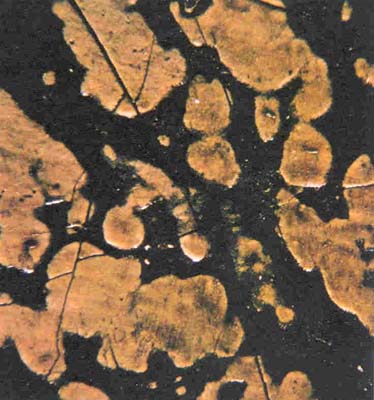
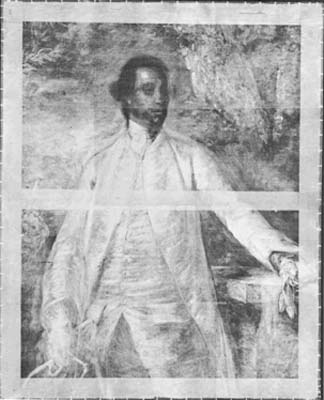
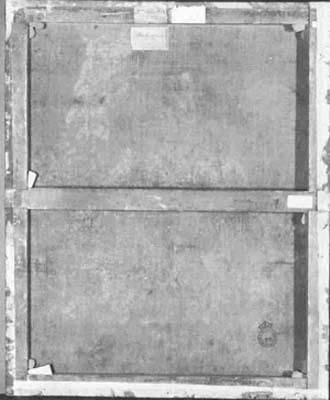
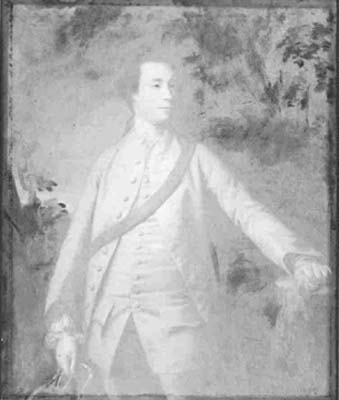
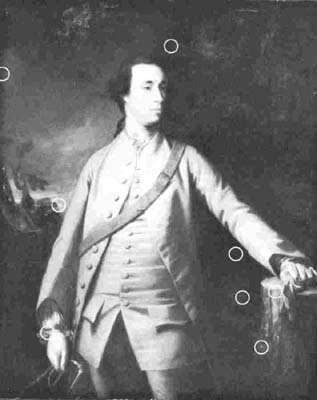
A
Reynolds Revived
by Mervyn Ruggles
Pages 1 | 2
| 3
The Portrait of Charles Churchill was cleaned and varnished
by F. W. Colley, a restorer under contract with the National Gallery
of Canada in 1923. (13) In recent years the natural-resin varnish,
dammar, had become extremely discoloured (fig. I), the flesh tone
shad
taken on a yellowish veil, and the background regions had lost all
detail under a dark, dull "craze" state similar to that
seen in old chinaware. Because of this and because the canvas,
though lined approximately a hundred years ago, was nevertheless
weak, worn away at the corners and splitting at the stretcher edges
(fig. 7), the National Conservation Research Laboratory initiated
a complete conservation treatment after a report in depth was
submitted. (14) The report included examination by X-ray (fig. 6),
infrared, and ultraviolet (fig. 8). The radiographs revealed that
Reynolds had revised the pose of the sitter's left hand, which had
originally rested on a parapet, and that foliage had formerly
existed in the upper left background and a leafy festoon near the
upper centre, above the head. The radiographs also proved that a
network of bitumen cracks had been covered over during previous
restorations. These were located practically all over the background
except in the sky at the upper left. Fortunately, no part of the
figure of Churchill had been affected by bitumen. Subsequent tests
with solvents indicated that the foliage at the upper left had been
painted over by Reynolds himself, but that the branch over the head
had been covered over much later by another hand. Only during the
removal of the discoloured varnish with a solvent mixture of equal
parts of acetone and tetrachlorethylene was the real extent of the
overpainting on much of the background revealed; the purpose had
been to disguise the extensive vein-like fissures of the traction
cracks (fig. 2). Gradually there began to emerge in several sectors
a series of white gesso-like islands on top of the original paint
film. The gesso, consisting of whiting bonded with animal glue, had
been trowelled on to smooth over the voids caused by the receding
paint film, and it covered a larger area than was necessary. The
photo-micrograph (fig. 3) shows one of these places. Solvent tests
in the section of the left hand indicate that the re-vision from a
parapet to a tree stump was indeed a change made by Reynolds, but
his reason still remains a matter of speculation. A rather
different story unfolded when the discoloured varnish came away
from the face. Strong white pigment with traces of faded carmine
could be detected, and a red colour was observed on the cheeks and
lips. It was readily established that these were retouches added
during a restoration, because they spanned the normal age cracks in
the original paint film (fig. 5).
Under the microscope the primary ground layer was a light grey
colour of the type applied commercially, pointing to the fact that
Reynolds did not prepare his own canvases but bought them already
mounted on a stretcher-frame. Over the whole sky sector he applied
an underlay or imprilllatura of blue-black prior to putting
in the sky. The tree at the right and the foliage were the next
stage. The blue-black underlay seems to influence somewhat the white
of the face, producing the ashen-grey colouration that is now
visible. Eight miniscule pigment samples (fig. 9), each one half the
diameter of a pin-head, were taken for X-ray diffraction and X-ray
spectroscopy by Mr. R. Boyer. (15) The results were as follows:
1 Yellow on the tree stump: yellow ochre and white lead
2 Green to the left of the tree stump: yellow ochre, Prussian blue
and white lead
3 Green under the left elbow: yellow ochre, Prussian blue and
white lead
4 Brown paint near the top of the tree stump: organic brown
(bitumen?) and white lead
5 White paint on the frill
of the right lace cuff: white lead
6 Yellow paint in the sky near the right elbow: Naples yellow
7 Blue paint at the upper left border: Prussian blue and white lead
8 Dark blue paint in the sky directly above the head: Prussian
blue and white lead
De Wild states that he had found that Naples yellow was in general
use only after 1759. (16) However, Kuhn (17) and others have established
that it was commonly used much earlier, and the existence of this
pigment in the Churchill picture indicates that it must have been
available to artists in London in Reynolds' time.
In making further reference to the paleness of the face, Buttery, a
London restorer, stated in 1958 that, "Owing to Reynolds'
carmine being a fugitive colour, his paintings of the fifties and
sixties appear to-day faded and cold. This coldness is frequently
increased by injudicious cleaning and lack of understanding of
Reynolds' methods at this date". (18) Strangely enough, the flesh
tones of the right hand do not exhibit this type of deterioration
nor do they have the same consistency as those of the face. The
hand still remains pinkish and only slightly faded. Because of this
aspect, one could speculate that this hand as well as the left
gloved hand, seemingly painted in the more conventional pigment
technique, was the work of Giuseppe Marchi, Reynolds' life-long
assistant who had accompanied him back from Rome in 1752. Or were
they perhaps painted by one of his other assistants - Peter Toms? The
hands in the Churchill painting appear to me, at least, to differ
from those of several other Reynolds' I have examined. A score of
assistants and pupils worked on Reynolds' pictures throughout his
career. (19)
After the varnish was removed, a scalpel was used to gently shave
away the gesso splatching. Overpainting in the foliated sections at
the upper right came away with the varnish coating. The old lining
canvas was taken off the back and the glue-paste adhesive was
carefully scraped away. The vacuum process (20) was employed to reline
the portrait with unbleached linen, using the special wax-resin
adhesive formulated at the National Gallery (yellow beeswax,
microcrystalline wax W-445, cyclohexanone resin, in proportions of 2
:2: I). A new custom-made stretcher-frame replaced the old one. A
minimum of inpainting with pigment in a synthetic resin medium was
necessary to match small, old paint losses. Finally, two coats of
cyclohex-anone resin in xylene were applied as protection.
The Portrait of Charles Churchill now has a fresh, revived
appearance (fig. 4) and, I believe, more closely approaches its
appearance when Reynolds painted it 216 years ago.
Next Page | Notes
1 | 2
| 3
Annual Index | Author & Subject | Credits | Contact
This digital collection
was produced under contract to Canada's Digital Collections program,
Industry Canada.
"Digital
Collections Program, Copyright
© National Gallery of
Canada 2001"